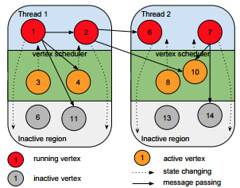Paper: FlashGraph: Processing Billion-Node Graphs on an Array of Commodity SSDs

It's amazing what you can accomplish these days on a single machine using SSDs and smart design. In the paper FlashGraph: Processing Billion-Node Graphs on an Array of Commodity SSDs they:
demonstrate that FlashGraph is able to process graphs with billions of vertices and hundreds of billions of edges on a single commodity machine.
The challenge is SSDs are a lot slower than RAM:
The throughput of SSDs are an order of magnitude less than DRAM and the I/O latency is multiple orders of magnitude slower. Also, I/O performance is extremely non-uniform and needs to be localized. Finally, high-speed I/O consumes many CPU cycles, interfering with graph processing.
Their solution exploits caching, parallelism, smart scheduling and smart placement algorithms:
We build FlashGraph on top of a user-space SSD file system called SAFS [32] to overcome these technical challenges. The set-associative file system (SAFS) refactors I/O scheduling, data placement, and data caching for the extreme parallelism of modern NUMA multiprocessors. The lightweight SAFS cache enables FlashGraph to adapt to graph applications with different cache hit rates. We integrate FlashGraph with the asynchronous user-task I/O interface of SAFS to reduce the overhead of accessing data in the page cache and memory consumption, as well as overlapping computation with I/O.
The result performs up to 80% of its in-memory implementation:
We observe that in many graph applications a large SSD array is capable of delivering enough I/Os to saturate the CPU. This suggests the importance of optimizing for CPU and RAM in such an I/O system. It also suggests that SSDs have been sufficiently fast to be an important extension for RAM when we build a machine for large-scale graph analysis applications.
Abstract:
Graph analysis performs many random reads and writes, thus, these workloads are typically performed in memory. Traditionally, analyzing large graphs requires a cluster of machines so the aggregate memory exceeds the graph size. We demonstrate that a multicore server can process graphs with billions of vertices and hundreds of billions of edges, utilizing commodity SSDs with minimal performance loss.
We do so by implementing a graph-processing engine on top of a user-space SSD file system designed for high IOPS and extreme parallelism. Our semi-external memory graph engine called FlashGraph stores vertex state in memory and edge lists on SSDs. It hides latency by overlapping computation with I/O. To save I/O bandwidth, FlashGraph only accesses edge lists requested by applications from SSDs; to increase I/O throughput and reduce CPU overhead for I/O, it conservatively merges I/O requests. These designs maximize performance for applications with different I/O characteristics.
FlashGraph exposes a general and flexible vertex-centric programming interface that can express a wide variety of graph algorithms and their optimizations. We demonstrate that FlashGraph in semi-external memory performs many algorithms with performance up to 80% of its in-memory implementation and significantly outperforms PowerGraph, a popular distributed in-memory graph engine




